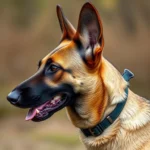
Introduction
Understanding dog breeds is crucial for potential pet owners, as each breed comes with its own unique characteristics, needs, and temperament. Among the fascinating breeds out there, the Bullweiler stands out as a unique and compelling choice for many families. This hybrid breed combines the strength and loyalty of the Rottweiler with the gentle temperament of the Bullmastiff, resulting in a dog that is not only protective but also affectionate.
In this article, we aim to inform readers about the Bullweiler, exploring its characteristics, history, care requirements, and training needs. Whether you are considering adding a Bullweiler to your family or simply want to learn more about this remarkable breed, this comprehensive guide will provide you with all the information you need.
What is a Bullweiler?
The Bullweiler is a mixed breed dog that results from crossing a Bullmastiff and a Rottweiler. This hybrid breed has gained popularity in recent years due to its unique combination of traits from both parent breeds. While the Bullweiler is not recognized by major kennel clubs, it has garnered a following among dog enthusiasts who appreciate its robust physique and loyal nature.
Origin and Breed Background
The origins of the Bullweiler can be traced back to the early 20th century when breeders sought to combine the best traits of the Bullmastiff and the Rottweiler. The Bullmastiff was originally bred in England to guard estates, while the Rottweiler has a history as a working dog in Germany, known for herding and guarding livestock. By blending these two breeds, the Bullweiler embodies the protective instincts of its ancestors while also being a loving companion.
Comparison with Parent Breeds
When comparing the Bullweiler to its parent breeds, you can see distinct traits that come into play. The Bullmastiff is often described as gentle and laid-back, while the Rottweiler is known for its intelligence and assertiveness. The Bullweiler generally inherits a balance of these characteristics, making it a versatile and adaptable dog.
Physical Characteristics
Size and Weight
The Bullweiler is a large breed, typically weighing between 80 to 120 pounds. Males are usually larger than females, with an average height ranging from 24 to 28 inches at the shoulder. As the Bullweiler matures, you can expect it to grow rapidly during its first year, reaching full size by around 18 to 24 months.
Coat and Colors
The coat of a Bullweiler is generally short, dense, and low-maintenance. Common colors include brindle, black, fawn, and combinations of these shades. The distinctive markings of the Rottweiler may also be present, giving the Bullweiler a striking appearance.
Distinctive Features
One of the most notable features of the Bullweiler is its muscular build, which gives it a powerful presence. The broad head and strong jawline reflect its Rottweiler heritage, while the Bullmastiff influence is evident in its sturdy body and gentle expression. This combination creates a dog that is both intimidating and endearing.
Temperament and Behavior
General Temperament
The Bullweiler is known for its loyalty and protective nature. This breed tends to form strong bonds with its family and is often wary of strangers, making it an excellent watchdog. However, it also possesses a gentle side, especially when socialized properly.
Socialization Needs
Early socialization is essential for a Bullweiler to develop into a well-adjusted adult. Exposure to different people, environments, and other animals will help your dog become more comfortable and confident in various situations. This breed typically gets along well with children and can be an affectionate companion for families.
Common Behavioral Traits
Bullweilers are known for their intelligence and playfulness. They are eager to learn and respond well to training, making them relatively easy to teach basic commands. However, without proper training and socialization, they may exhibit stubbornness or even aggression, so it’s crucial to establish a solid training foundation.
Health Considerations
Common Health Issues
Like all breeds, the Bullweiler is prone to certain health issues, including hip dysplasia, heart problems, and obesity. Regular health check-ups and screenings can help catch these issues early, ensuring your Bullweiler maintains optimal health.
Regular Health Check-ups
Routine veterinary visits are vital for monitoring your Bullweiler’s health. Regular vaccinations, parasite prevention, and dental care should be part of your dog’s healthcare routine. Early detection of any health problems can improve treatment outcomes.
Lifespan and Aging
The average lifespan of a Bullweiler ranges from 8 to 12 years, depending on genetics, care, and overall health. As your Bullweiler ages, it’s important to adapt its diet and exercise routine to accommodate its changing needs. Senior dogs may require specialized diets or more frequent vet visits to manage health issues that arise with age.
Care Requirements
Dietary Needs
Providing a balanced diet is essential for the health and well-being of your Bullweiler. High-quality dog food that meets the nutritional requirements for large breeds is recommended. Pay attention to portion sizes to prevent obesity, as this breed can be prone to weight gain.
Exercise Requirements
Bullweilers are active dogs that require daily exercise to stay healthy and happy. Aim for at least 60 to 90 minutes of physical activity each day, which can include walks, playtime in the yard, or engaging in dog sports. Mental stimulation is also important, so consider incorporating puzzle toys or training sessions into your routine.
Grooming
Grooming a Bullweiler is relatively easy, given its short coat. Regular brushing can help keep shedding to a minimum and promote healthy skin. Don’t forget to include dental care and ear cleaning in your grooming routine, as these can often be overlooked.
Training and Socialization
Basic Training Techniques
Obedience training is crucial for a Bullweiler, as it helps establish boundaries and strengthens the bond between you and your dog. Focus on teaching essential commands like sit, stay, come, and heel. Positive reinforcement methods, such as treats and praise, work best for this breed.
Socialization Strategies
To properly socialize your Bullweiler, introduce it to new environments, people, and other animals gradually. Puppy classes can be beneficial, as they provide opportunities for your dog to interact with others in a controlled setting. Aim to expose your dog to a variety of experiences to build confidence and reduce anxiety.
Addressing Behavioral Issues
Common behavioral problems in Bullweilers may include excessive barking, chewing, or aggression if not properly managed. Consistency is key in addressing these issues; use positive reinforcement techniques and establish clear rules. If problems persist, consider consulting a professional dog trainer or behaviorist.
Living with a Bullweiler
Ideal Living Environment
The Bullweiler can adapt to various living situations, but it thrives best in a home with a large yard where it can play and exercise freely. While apartment living is possible, ensure your dog receives ample outdoor time and exercise daily.
Family Compatibility
This breed is generally compatible with families, including those with children and seniors. Their protective instincts make them excellent companions, but supervision is important, especially with younger children. Teaching kids how to interact with the dog respectfully is essential for fostering a harmonious relationship.
Time Commitment
Owning a Bullweiler requires a significant time commitment. From daily exercise to training and socialization, expect to dedicate several hours each day to your dog’s needs. This commitment is crucial for raising a well-adjusted and happy pet.
Adoption and Purchase Considerations
Finding a Reputable Breeder
When looking for a Bullweiler, it’s essential to find a reputable breeder who prioritizes health and temperament. Ask potential breeders about health screenings for both parent dogs, and request references from previous puppy buyers. A responsible breeder will be open about the breed’s characteristics and any potential health concerns.
Adoption Options
Adopting a Bullweiler from a rescue organization or shelter is another option worth considering. Many mixed-breed dogs are in need of loving homes, and adopting can be a rewarding experience. Research local rescue groups that specialize in large breeds or mixed breeds to find a suitable match.
Cost Considerations
The initial costs of acquiring a Bullweiler can vary depending on whether you choose to buy from a breeder or adopt from a shelter. Expect to pay anywhere from $500 to $2,000 for a puppy from a reputable breeder, while adoption fees typically range from $100 to $300. Long-term costs, including food, healthcare, and grooming, should also be factored into your budget.
Conclusion
In summary, the Bullweiler is a unique and loyal breed that can make a wonderful addition to the right family. With its protective instincts, affectionate nature, and adaptability, this hybrid dog has much to offer. Understanding its characteristics, care requirements, and training needs is essential for ensuring a happy and healthy life for your Bullweiler.
If you are considering bringing a Bullweiler into your home, remember that responsible pet ownership involves a long-term commitment to your dog’s well-being. By providing love, training, and proper care, you can enjoy a rewarding companionship with this remarkable breed.
Additional Resources
For those interested in learning more about Bullweilers, consider exploring reputable breed organizations, reading books focused on this breed, and connecting with local trainers and veterinarians who specialize in large breeds. These resources can provide valuable insights and support as you embark on your journey as a Bullweiler owner.









